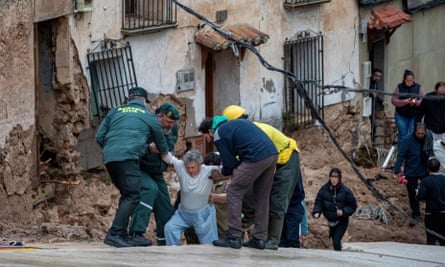At least 51 people are feared to have died after torrential rains hit southern and eastern Spain on Tuesday, bringing flash floods that raged through towns and cut off roads and rail lines.
As the search continued for the missing, people were urged to stay off the roads amid warnings that the number of fatalities could rise.
Speaking on Wednesday morning, the president of the eastern region of Valencia said it was still too early to provide a comprehensive death toll.
“These are very difficult hours for relatives and for the disappeared,” said Carlos Mazón. “We will confirm the number of victims over the coming hours but right now it’s impossible to offer a precise figure. We’re in shock.”
The Valencian government’s emergency coordination centre said its multiple victims protocol had been activated, adding: “The initial toll logged by different police and emergency services puts the provisional number of victims at 51 people. We are beginning the process of recovering and identifying the victims.”

The regional government also urged people to stay off flooded or cut-off roads, saying the emergency services needed access and that more flood water could still accumulate.
Images on Spanish TV showed turbulent, muddy water surging through the town of Letur in the eastern province of Albacete on Tuesday, dragging cars through its streets.
“I am closely following with concern the reports on missing persons and the damage caused by the storm in recent hours,” Spain’s prime minister, Pedro Sánchez, wrote on X, urging people to follow the advice of the authorities.
“Be very careful and avoid unnecessary trips,” he added.
It was later announced that Sánchez would chair a crisis meeting on the floods in Madrid at midday.
The intense rain has been attributed to a phenomenon known as the gota fría, or “cold drop”, which occurs when cold air moves over the warm waters of the Mediterranean Sea. This creates atmospheric instability, causing warm, saturated air to rise rapidly, leading to the formation of towering cumulonimbus clouds in a matter of hours and dumping heavy rain across eastern parts of Spain.
Scientists say extreme weather such as heatwaves and storms is becoming more intense as a result of the climate crisis.